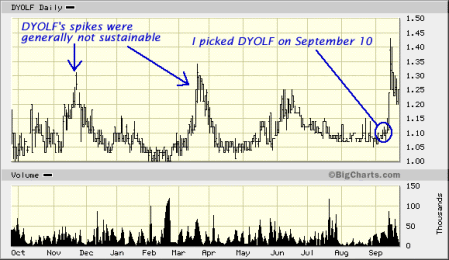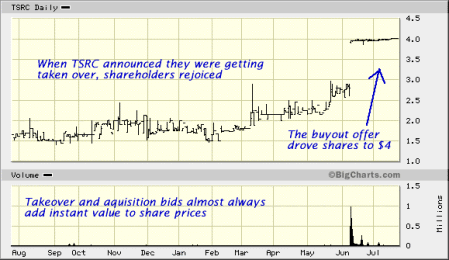


Get Instant Penny Stock Picks from the Authority!Visit www.PeterLeeds.com Right Now!
There are many differences between penny stocks and other types of investments, which means that your investment approach towards penny stocks must be adapted accordingly.
For a full discussion of all the differences, be sure to read Big Stocks vs. Penny Stocks.
Compare Penny Stocks to More Conventional Blue-Chip Stocks
| Penny Stocks | Blue-Chips | |
| Value and Predictability | Less actual value in penny stocks, greater perceived potential, less predictable | Safer but boring, no potential for a price explosion |
| Speculation | Highly speculative. For some penny stocks, speculation is all they have going, while others see their shares soar on speculative buying. | Little or no speculative value. |
| Fundamental Analysis and Information Availability | Poor visibility levels, lower reporting responsibility with penny stocks. Can be researched properly if Leeds Analysis is applied. | Well known, heavily followed companies have a wealth of information available. |
| Technical Analysis | TA methods can not be applied to penny stocks, except for proprietary techniques and indicators. | TA can be easily applied to high volume shares. |
| Volatility | Highly volatile, with more frequent profit-taking opportunities, and greater price swings. | More secure and insulated from volatility. |
| Spread | Greater percentage difference between prices of buyers and sellers. | High volume stocks have very little spread between the bid (buying offer) and the ask (selling offer) prices. |
| Risk / Reward Ratio | The risks are higher, while the potential rewards are much greater. | Less risk, less reward potential. |
| Ease of Acquisition | More complicated to purchase some types of penny stocks, such as those trading Over-The-Counter. | Much easier to trade through your broker, no special commission rates. |
| Revenues and Company Life-Cycle | Lower, or no actual revenues. Initial or growth stage companies. | Mature or advanced companies, less growth but greater revenue streams. |
| Revenues and Company Life-Cycle | Lower, or no actual revenues. Initial or growth stage companies. | Mature or advanced companies, less growth but greater revenue streams. |
| Dividends | Very rarely pay or are in the position to pay dividends. | Many blue-chip stocks pay dividends. |
| Takeover or Acquisition Targets | More likely to be taken over by another company, which is usually very beneficial to the price of the shares. | More likely to be the company purchasing or taking over the smaller player, which is usually detrimental to the price of shares at first. |
| Industry and Sector Influences | Highly exposed to sector influences, to the potential benefit or detriment of the shares. | Insulated to the impacts of the sector and industry. |
| Economies of Scale and Niche Marketing | Niche marketing is more important, because penny stocks can not compete with the economies of scale of the bigger players in their field. | Benefit from economies of scale, but can not respond, react, or adapt to the smaller companies quickly enough. Often leave niches exposed for penny stock companies to capitalize. |
| Driving Factors vs. Fiscal Situation | Share price is not strongly tied to fundamental results and the balance sheet with penny stocks. | Fundamental results and the balance sheet are the most important factor to the share price. |
| Irrational Spikes and Profit Opportunities | Penny stocks have more frequent and extreme spikes and dips, from less provocation. | More stable, less volatile. |
| Broker Policies | For certain types of penny stocks, brokers can charge greater commissions, or be problematic. | Brokers will not be problematic for trades in blue chip stocks. |
| Investment Horizon | Gains can be seen in short time frames, from hours or days, to weeks or months. | It often takes larger, slow-moving companies years for their share prices to advance meaningfully. |
The difference between the bid and the ask price is generally greater for penny stocks. (To learn more about price spread, review the section entitled Trading Stocks).
This is due to two factors
The spread between bid and ask prices for penny stocks can often be greater than 10%, so it is very important to use a LIMIT order rather than a MARKET order, so as to ensure the trading price of the shares you buy or sell. (Learn about market and limit orders in section entitled Trading Stocks.
Penny stocks are often very volatile and can make large percentage moves in short time frames. This means that investors should keep a watchful eye on their investments, rather than buying and holding for the long term. While there are many penny stocks available which may be long term investments, they still need to be monitored very closely due to their volatility.

Forces driving penny stocks are very different than those affecting the share prices of other types of investments. For example, speculation, promotional efforts, seasonality, and 'potential' are a few criteria which should be examined in greater depth with penny stocks than other investments.
As well, depending on the type of company, patents and technological innovations, success of surrounding exploration claims, past management effectiveness, and corporate alliances can also play a major role in the direction of the share price.
While other criteria do apply, such as technical indicators, standard fundamental analysis, insider trading, and institutional sponsorship, they impact the underlying stock differently depending if it is a small company or a large company.
The smaller relative size of many penny stocks and penny stock companies makes them more likely to be taken over by larger corporations in the same industry.

As well, many smaller companies have the rights to important exploration lands, technology patents, or strategic market share which they don't have the resources to effectively exploit, meaning that larger corporations can move in and benefit where the smaller penny stock company was unable to.
When a company gets taken over it is usually to the benefit of the shareholders, as they often realize a price increase in their holdings. This is because the buyer pays a premium above the recent share price to entice current shareholders.
The reasons for investing in penny stocks generally involves the hope of large, significant profit. The average investor will hold their shares in a penny stock company for shorter time periods than they would for a blue chip corporation, and will hold out for significant profits before selling their shares. This is important to consider when gaining an understanding of investor sentiment towards a particular company, and extrapolating share price movements from that understanding.
Investor expectations in penny stocks are also different as they relate to company operations. It is generally more acceptable for a small cap penny stock company to be losing money, over-spending on research and development, or growing very rapidly.
It is less than acceptable from an investor's point of view for a penny stock company to be undergoing negative or nil growth, to be paying dividends, or to be diversifying among non-related industries.